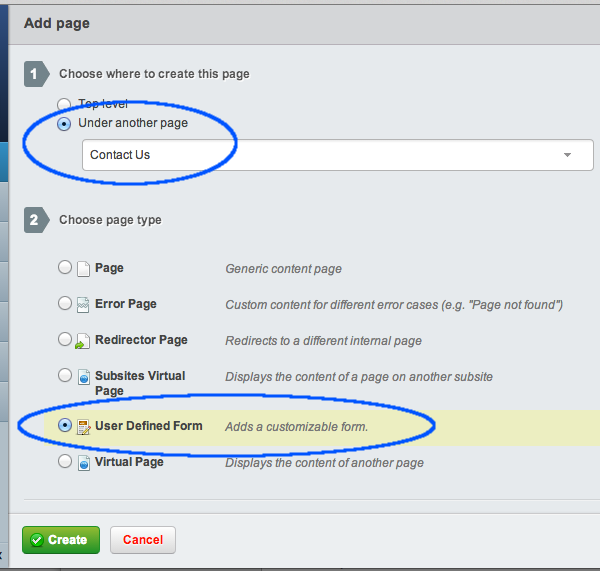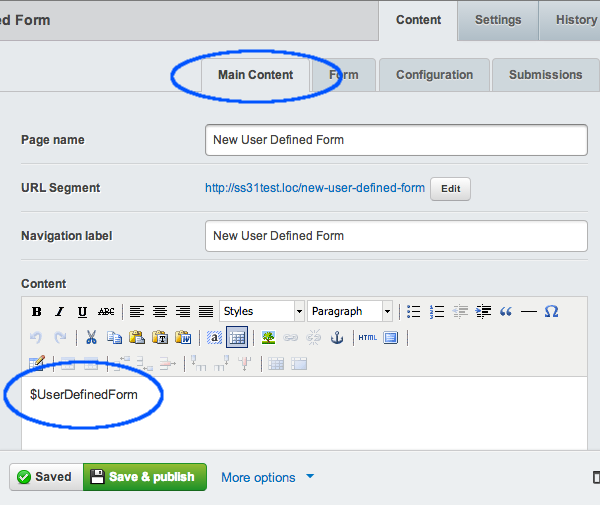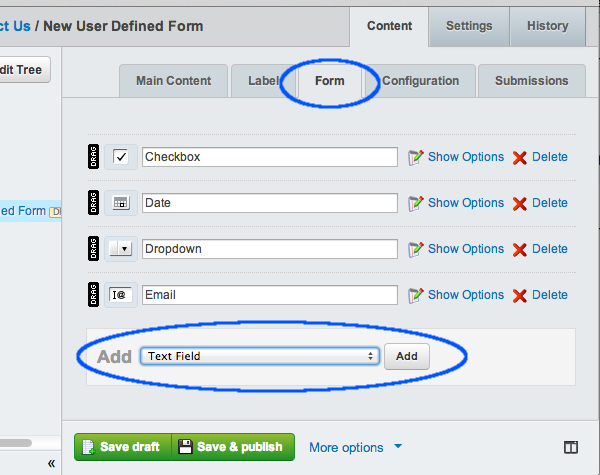7.3 KiB
User Documentation
In this section:
- Learn how to create and edit forms
- Learn how to add fields to a form
- Learn how to view submissions and reply to them automatically
Before we begin:
- Make sure you are in the "Pages" section on the Navigation Tabs.
Creating and editing forms
To create a new form, first decide where in the site you want your form to be. If you would like your form to be a "subpage" of an already existing page, click on the parent page in the left-hand Page Tree in the Contents Pane you would like to create the subpage in. If you want your form to be in the top level navigation for your site, you should click on the root of the site - the first item listed in the Contents Pane.
On the top of the Contents Pane, you will find a button marked "Create." Click it, and a drop-down menu will show up. Select "User Defined Form" Then hit the "Go" button.
You will notice that a new page has been created, with the name of "New UserDefinedForm."
Simply click on the new page in the content page to bring it up in the editing pane.
Don't worry if you create your page in the "wrong" place. Pages can be moved and re-ordered easily, and we will cover that under "Managing Your Site."
Combining forms and content
Much like editing any form page, you can add context, such as text or images, in the Main section of the Contents tab on in the Editing Pane. Form pages are slightly different, however. You will notice in a newly created form page, there is some text in the content of the editing menu to begin with: "$UserDefinedForm"
The purpose of this little block of text is to tell the website where in the page you would like to put the form. The form will appear on the website wherever the "$UserDefinedForm" appears in the editing pane, whether it is before text, after text, inside a table, etc.
If $UserDefinedForm is deleted by accident or on purpose, SilverStripe automatically puts the form at the end of all the content.
Adding fields
To add a field to the form, click on the "Form" tab under the "Content" tab in the Editing Pane. Select the type of field you want to add from the drop-down menu and press the "Add" button. You can label any field by typing in the appropriate label field in the backend.
Field types
Checkbox Field
Selecting a checkbox field adds a single checkbox to a form, along with a place to store a label for that checkbox. This is useful for getting information that has a "Yes or No" answer, such as "Would you like to be contacted?" or "Have you understood the Terms and Conditions?"
Marking this field as required will require it to be checked.
Checkbox Group
Selecting a checkbox group adds a field for multiple checkboxes to a form, along with a place to store a label for the group. This is useful for getting information that has multiple discrete answers, such as "Which continents have you visited?" or "Which software programs do you use on a daily basis?" You will need to click on the "Show options" link to add user-selectable options.
Marking this field as required will require at least one option to be checked.
Country Dropdown
A list of all countries drawn from the internal list of known countries.
Date Field
Selecting a date field adds a field for a date in a form. The time of day is not selectable, however.
If your theme enables it, a date picker popup will be displayed to the user on the frontend.
Dropdown Field
Selecting a drop-down field adds a dropdown field to a form. This is useful for getting information that has only one answer among several discrete choices, for example, "Which region do you live in?" or "What subject is your question about?" You will need to click on the "Show options" link to add user-selectable options.
Email Field
Selecting an Email field adds a textbox where an email address can be entered. Using the Email field, instead of a normal text field, to store email addresses, allows you to use that email address in many automated tasks. For example, it allows the CMS to send reply email automatically when a form is filled out.
File Upload Field
Selecting a File Upload Field adds a field where users can upload a file from their computers. This is useful for getting documents and media files.
The folder that this field uploads to can be customised by selecting "Show Options" and then selecting a new folder from the "Select upload folder" option. If no folder is selected it will upload by default to the "Uploads" folder.
Heading
Selecting a Heading allows adds a place where you can put a heading for a form, or for a section of your form. You can choose which level of heading to use (from 1-6) from the "Show options" link.
If you do not check the "Hide from reports" checkbox then this field will be displayed in submission reports.
HTML Block
Selecting an HTML block allows you to add any HTML code you wish into your form. You can edit the HTML blog from the "Show options" link.
If you do not check the "Hide from reports" checkbox then this field will be displayed in submission reports.
Note: Take care not to allow input from unauthorised sources or users, as custom script or code could be injected into your form.
Member List Field
Selecting a Member List Field adds a dropdown field which includes various groups of website members (such as administrators or forum members) to the form. You can choose which group of members from the "Show Options" link.
Note: Take care that you do not expose confidential or personal information about your CMS or front end users as these names will become publicly visible.
Numeric Field
A basic text field that will only accept numeric values (numbers and decimals only).
Radio Field
Selecting a Radio field adds a field filed with "Radio button" options to a form. Radio buttons are similar to checkboxes, except that only one button in a radio field can be checked at a time. This is useful for getting information that has only one answer among several discrete choices, for example, "What country do you live in?" or "What subject is your question about?" It is similar to a dropdown field, but it is more useful for providing larger labels to responses. For example, a dropdown field may have one or two-word inputs, while a radio button may have choices that are paragraphs in length. You will need to click on the "Show options" link to add user-selectable options.
Text Field
Selecting a Text field adds a text field to the form. You can click on "Show options" to determine the size and the number of rows in a text field.
Put another way, if you'd like to create a question that...
- Has a yes or no answer - use Checkbox Field.
- Has multiple possible answers, from a list of choices - use Checkbox Group.
- Has one answer, from a list of choices - use Dropdown Field (for short answers) or Radio Field (for longer answers).
- Requires a written answer - use Text Field.
Or perhaps you'd like to add informational content to your form?
- Use HTML Block, with the appropriate level Heading.


